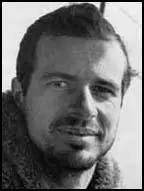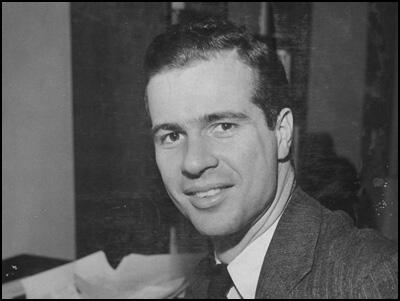John Hersey

John Hersey, the son of US missionary parents, was born in China on 17th June, 1914. After graduating from Yale University he became correspondent in the Far East for Time Magazine.
During the Second World War Hersey also wrote for Life magazine and the New Yorker. He accompanied the US Army in the invasion of Sicily and Italy. Hersey used some of the information he gathered as a war journalist for his best-selling novel A Bell for Adano (1944). The book won the Pulitzer Prize in 1945.
In 1944 Hersey covered the war in the Pacific and his many articles included one detailing the heroism of Lieutenant John F Kennedy when his Motor Torpedo Boat was sunk close to the Soloman Islands.
Hersey was one of the first western journalists to arrive in Hiroshima after the atom bomb explosion on 6th August 1945. Commission by the New Yorker to write a series of articles on the effects of a nuclear explosion, he decided to focus on the experiences of six people who had been in the city: two doctors, a Protestant minister, a widowed seamstress, a young female factory worker and a German Catholic priest. When the editor saw the articles he decided to devote one issue (31st August, 1946) to the material. Later that year it was published as the book Hiroshima (1946).

Other books by Hersey include the Child Buyer (1947), The Wall (1950), The Marmot Drive (1953), A Single Pebble (1956), The War Lover (1959), The Child Buyer (1960), White Lotus (1965), Too Far To Walk (1966), Under the Eye of the Storm (1967), The Conspiracy (1972), My Petition for More Space (1974),The Walnut Door (1977), Antonietta (1991) and Key West Tales (1993).
Primary Sources
(1) John Hersey wrote about the heroism of John F. Kennedy after interviewing members of the crew of the American Motor Torpedo Boat that sank in the Blackett Straight. The article appeared in the New Yorker on 17th June 1944.
All morning they watched for the plane which they thought would be looking for them. They cursed war in general and PTs in particular. At about ten o'clock the hulk heaved a moist sigh and turned turtle. McMahon and Johnston had to hang on as best they could. It was clear that the remains of the 109 would soon sink. When the sun had passed the meridian, Kennedy said, "We will swim to that small island," pointing to one of a group three miles to the southeast. "We have less chance of making it than some of these other islands here, but there'll be less chance of Japs, too." Those
who could not swim well grouped themselves around a long two-by-six timber with which carpenters had braced the 37-millimetre cannon on deck and which had been knocked overboard by the force of the collision. They tied several pairs of shoes to the timber, as well as the ship's lantern, wrapped in a life jacket to keep it afloat. Thorn took charge of this unwieldy group. Kennedy took McMahon in tow again. He cut loose one end of a long strap on McMahon's Mae West and took the end in his teeth. He swam breast stroke, pulling the helpless McMahon along on his back. It took over five hours to reach the island. Water lapped into Kennedy's mouth through his clenched teeth, and he swallowed a lot. The salt water cut into McMahon's awful burns, but he did not complain. Every few minutes, when Kennedy stopped to rest,
taking the strap out of his mouth and holding it in his hand, McMahon would simply say, "How far do we have to go?"
Kennedy would reply, "We're going good." Then he would ask, "How do you feel, Mac?"
McMahon always answered, "I'm OK, Mr Kennedy. How about you?"
In spite of his burden, Kennedy beat the other men to the reef that surrounded the island. He left McMahon on the reef and told him to keep low, so as not to be spotted by Japs. Kennedy went ahead and explored the island. It was only a hundred yards in diameter; coconuts on the trees but none on the ground, no visible Japs. Just as the others reached the island, one of them spotted a Japanese barge chugging along close to shore. They all lay low. The barge went on.
(2) John Hersey, Hiroshima (1946)
On August 7th, the Japanese radio broadcast for the first time a succinct announcement that very few, if any, of the people most concerned with its content, the survivors in Hiroshima, happened to hear: "Hiroshima suffered considerable damage as the result of an attack by a few B-29s. It is believed that a new type of bomb was used. The details are being investigated." Nor is it probable that any of the survivors happened to be tuned in on a short-wave rebroadcast of an extraordinary announcement by the president of the United States, which identified the new bomb as atomic: "That bomb had more power than twenty thousand tons of TNT. It had more than two thousand times the blast power of the British Grand Slam, which is the largest bomb ever yet used in the history of warfare." Those victims who were able to worry at all about what had happened thought of it and discussed it in more primitive, childish terms – gasoline sprinkled from an airplane, maybe, or some combustible gas, or a big cluster of incendiaries, or the work of parachutists; but, even if they had known the truth, most of them were too busy or too weary or too badly hurt to care that they were the objects of the first great experiment in the use of atomic power, which (as the voices on the short wave shouted) no country except the United States, with its industrial know-how, its willingness to throw two billion gold dollars into an important wartime gamble, could possibly have developed.
(3) John Hersey, Hiroshima (1946)
The lot of Drs. Fujii, Kanda, and Machii right after the explosion–and, as these three were typical, that of the majority of the physicians and surgeons of Hiroshima–with their offices and hospitals destroyed, their equipment scattered, their own bodies incapacitated in varying degrees, explained why so many citizens who were hurt went untended and why so many who might have lived died. Of a hundred and fifty doctors in the city, sixty-five were already dead and most of the rest were wounded. Of 1,780 nurses, 1,654 were dead or too badly hurt to work. In the biggest hospital, that of the Red Cross, only six doctors out of thirty were able to function, and only ten nurses out of more than two hundred. The sole uninjured doctor on the Red Cross Hospital staff was Dr. Sasaki. After the explosion, he hurried to a storeroom to fetch bandages. This room, like everything he had seen as he ran through the hospital, was chaotic–bottles of medicines thrown off shelves and broken, salves spattered on the walls, instruments strewn everywhere. He grabbed up some bandages and an unbroken bottle of mercurochrome, hurried back to the chief surgeon, and bandaged his cuts. Then he went out into the corridor and began patching up the wounded patients and the doctors and nurses there. He blundered so without his glasses that he took a pair off the face of a wounded nurse, and although they only approximately compensated for the errors of his vision, they were better than nothing.
(4) John Hersey, Hiroshima (1946)
Dr. Sasaki and his colleagues at the Red Cross Hospital watched the unprecedented disease unfold and at last evolved a theory about its nature. It had, they decided, three stages. The first stage had been all over before the doctors even knew they were dealing with a new sickness; it was the direct reaction to the bombardment of the body, at the moment when the bomb went off, by neutrons, beta particles, and gamma rays. The apparently uninjured people who had died so mysteriously in the first few hours or days had succumbed in this first stage. It killed ninety-five per cent of the people within a half-mile of the center, and many thousands who were farther away. The doctors realized in retrospect that even though most of these dead had also suffered from burns and blast effects, they had absorbed enough radiation to kill them. The rays simply destroyed body cells– caused their nuclei to degenerate and broke their walls. Many people who did not die right away came down with nausea, headache, diarrhea, malaise, and fever, which lasted several days. Doctors could not be certain whether some of these symptoms were the result of radiation or nervous shock. The second stage set in ten or fifteen days after the bombing. Its first symptom was falling hair. Diarrhea and fever, which in some cases went as high as 106, came next. Twenty-five to thirty days after the explosion, blood disorders appeared: gums bled, the white-blood-cell count dropped sharply, and petechiae [eruptions] appeared on the skin and mucous membranes. The drop in the number of white blood corpuscles reduced the patient's capacity to resist infection, so open wounds were unusually slow in healing and many of the sick developed sore throats and mouths. The two key symptoms, on which the doctors came to base their prognosis, were fever and the lowered white-corpuscle count. If fever remained steady and high, the patient's chances for survival were poor. The white count almost always dropped below four thousand; a patient whose count fell below one thousand had little hope of living. Toward the end of the second stage, if the patient survived, anemia, or a drop in the red blood count, also set in. The third stage was the reaction that came when the body struggled to compensate for its ills–when, for instance, the white count not only returned to normal but increased to much higher than normal levels. In this stage, many patients died of complications, such as infections in the chest cavity. Most burns healed with deep layers of pink, rubbery scar tissue, known as keloid tumors. The duration of the disease varied, depending on the patient's constitution and the amount of radiation he had received. Some victims recovered in a week; with others the disease dragged on for months.
As the symptoms revealed themselves, it became clear that many of them resembled the effects of overdoses of X-ray, and the doctors based their therapy on that likeness. They gave victims liver extract, blood transfusions, and vitamins, especially Bl. The shortage of supplies and instruments hampered them. Allied doctors who came in after the surrender found plasma and penicillin very effective. Since the blood disorders were, in the long run, the predominant factor in the disease, some of the Japanese doctors evolved a theory as to the seat of the delayed sickness. They thought that perhaps gamma rays, entering the body at the time of the explosion, made the phosphorus in the victims' bones radioactive, and that they in turn emitted beta particles, which, though they could not penetrate far through flesh, could enter the bone marrow, where blood is manufactured, and gradually tear it down. Whatever its source, the disease had some baffling quirks. Not all the patients exhibited all the main symptoms. People who suffered flash burns were protected, to a considerable extent, from radiation sickness. Those who had lain quietly for days or even hours after the bombing were much less liable to get sick than those who had been active. Gray hair seldom fell out. And, as if nature were protecting man against his own ingenuity, the reproductive processes were affected for a time; men became sterile, women had miscarriages, menstruation stopped.

